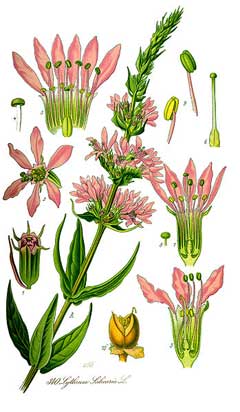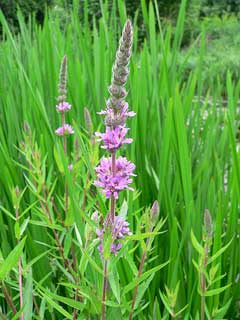 |
|
http://commons.wikimedia.org/wiki/File:Illustration_Lythrum_salicaria1.jpg |
 |
| http://commons.wikimedia.org/wiki/User:BS_Thurner_Hof |
Translate this page:
Summary
Bloom Color: Pink. Main Bloom Time: Late summer, Mid summer. Form: Upright or erect.
Physical Characteristics

 Lythrum salicaria is a PERENNIAL growing to 1 m (3ft 3in) by 0.5 m (1ft 8in) at a fast rate.
Lythrum salicaria is a PERENNIAL growing to 1 m (3ft 3in) by 0.5 m (1ft 8in) at a fast rate.
See above for USDA hardiness. It is hardy to UK zone 3. It is in flower from June to August, and the seeds ripen from August to September. The species is hermaphrodite (has both male and female organs) and is pollinated by Bees, flies.
It is noted for attracting wildlife.
Suitable for: light (sandy), medium (loamy) and heavy (clay) soils and can grow in heavy clay soil. Suitable pH: mildly acid, neutral and basic (mildly alkaline) soils. It can grow in semi-shade (light woodland) or no shade. It prefers moist or wet soil and can grow in water.
UK Hardiness Map
US Hardiness Map
Synonyms
Plant Habitats
Pond; Bog Garden;
Edible Uses
Edible Parts: Leaves Root
Edible Uses: Colouring
Leaves - cooked[13, 46, 61, 105]. Rich in calcium[179]. Root - cooked[13]. An edible dye is obtained from the flowers[13].
References More on Edible Uses
Medicinal Uses
Plants For A Future can not take any responsibility for any adverse effects from the use of plants. Always seek advice from a professional before using a plant medicinally.
Antibiotic Antidiarrhoeal Astringent Dysentery Eczema Hypoglycaemic Styptic Vulnerary
Purple loosestrife is an astringent herb that is mainly employed as a treatment for diarrhoea and dysentery. It can be safely taken by people of all ages and has been used to help arrest diarrhoea in breast-feeding babies[254]. It can also be used to treat heavy periods and inter-menstrual bleeding[254]. Modern research has shown the whole plant to be antibiotic and to be particularly effective against the micro-organism that causes typhus[254]. The flowering plant is antibiotic, highly astringent, hypoglycaemic, styptic and vulnerary[4, 7, 9, 21, 152, 218, 238]. It is valued as an intestinal disinfectant, especially in cases of enteritis[7], an infusion is used internally in the treatment of diarrhoea, internal bleeding, excessive menstruation etc[9, 222, 238]. The flowering plant is harvested in the summer and can be used fresh or dried[9]. Externally, the plant is used as a cleansing and healing wash for wounds, sores, impetigo, eczema, excess vaginal discharge, vaginal itching etc[7, 222, 238, 254]. The powdered plant is used as a haemostatic in cases of severe nosebleeds[7]. The stems are regarded as gum stimulators and are given to children to chew in order to strengthen weak or bleeding gums[7].
References More on Medicinal Uses
The Bookshop: Edible Plant Books
Our Latest books on Perennial Plants For Food Forests and Permaculture Gardens in paperback or digital formats.

Edible Tropical Plants
Food Forest Plants for Hotter Conditions: 250+ Plants For Tropical Food Forests & Permaculture Gardens.
More

Edible Temperate Plants
Plants for Your Food Forest: 500 Plants for Temperate Food Forests & Permaculture Gardens.
More

More Books
PFAF have eight books available in paperback and digital formats. Browse the shop for more information.
Shop Now
Other Uses
Cosmetic Dye Preservative Tannin Teeth
A decoction of the plant is impregnated into wood, rope etc to prevent it rotting in water[74]. The leaves contain about 12% tannin, the stems 10.5%, the flowers 13.7% and the roots 8.5%[218]. It is probably these tannins that preserve the wood etc[218]. The powdered plant is used cosmetically in face-packs to counteract reddened skin[7].
Special Uses
Attracts Wildlife Food Forest
References More on Other Uses
Cultivation details
Landscape Uses:Container, Massing, Rock garden, Seashore, Specimen. Succeeds in ordinary garden soil, especially if it is damp[1]. Prefers a neutral to alkaline soil[238]. Grows well in heavy clay soils. Grows well in marshy soils[24] and succeeds in shallow water at the edges of ponds[56]. Succeeds in full sun or partial shade[188]. A very hardy plant, tolerating temperatures down to at least -25°c[187]. This species can be very invasive and has been declared a noxious weed in some countries. Since being introduced in N. America it has invaded native marshlands, florming large areas of dense stands and crowding out many native species[274]. A very ornamental plant[1]. A good bee and butterfly plant[24]. Plants usually self-sow when well sited[200]. Special Features:Invasive, Naturalizing, Attracts butterflies, Suitable for cut flowers. In garden design, as well as the above-ground architecture of a plant, root structure considerations help in choosing plants that work together for their optimal soil requirements including nutrients and water. The root pattern is rhizomatous with underground stems sending roots and shoots along their length [2-1].
References Carbon Farming Information and Carbon Sequestration Information
Temperature Converter
Type a value in the Celsius field to convert the value to Fahrenheit:
Fahrenheit:
The PFAF Bookshop
Plants For A Future have a number of books available in paperback and digital form. Book titles include Edible Plants, Edible Perennials, Edible Trees,Edible Shrubs, Woodland Gardening, and Temperate Food Forest Plants. Our new book is Food Forest Plants For Hotter Conditions (Tropical and Sub-Tropical).
Shop Now
Plant Propagation
Seed - sow in the autumn or the spring in a cold frame. When they are large enough to handle, prick the seedlings out into individual pots and plant them out in the summer. If you have sufficient seed it could be worthwhile trying a sowing in situ in the autumn or the spring. Division in March or October[188]. Larger clumps can be replanted direct into their permanent positions, though it is best to pot up smaller clumps and grow them on in a cold frame until they are rooting well. Plant them out in the spring. Basal cuttings in the spring[238]. Harvest the shoots with plenty of underground stem when they are about 8 - 10cm above the ground. Pot them up into individual pots and keep them in light shade in a cold frame or greenhouse until they are rooting well. Plant them out in the summer.
Other Names
If available other names are mentioned here
Native Range
TEMPERATE ASIA: Afghanistan, Iran, Israel, Jordan, Lebanon, Syria, Turkey, Russian Federation-Ciscaucasia (Ciscaucasia), Armenia, Azerbaijan, Georgia, Russian Federation (Dagestan), Russian Federation-Eastern Siberia (Eastern Siberia), Mongolia, Russian Federation (Primorye, Amur, Sakhalin), China (throughout), Japan (Hokkaidô, Honshu, Kyushu, Shikoku) EUROPE: Denmark, Finland, United Kingdom, Ireland, Norway, Sweden, Austria, Belgium, Switzerland, Czech Republic, Germany, Hungary, Netherlands, Poland, Slovakia, Russian Federation (European part), Belarus, Estonia, Lithuania, Latvia, Moldova, Ukraine (incl. Krym), Albania, Bulgaria, Bosnia and Herzegovina, Greece, Croatia, Italy (incl. Sardinia, Sicily), Montenegro, Romania, Serbia, Slovenia, Spain, France (incl. Corsica), Portugal AFRICA: Algeria, Morocco, Tunisia
Weed Potential
Right plant wrong place. We are currently updating this section.
Please note that a plant may be invasive in one area but may not in your area so it's worth checking.
Conservation Status
IUCN Red List of Threatened Plants Status :

Growth: S = slow M = medium F = fast. Soil: L = light (sandy) M = medium H = heavy (clay). pH: A = acid N = neutral B = basic (alkaline). Shade: F = full shade S = semi-shade N = no shade. Moisture: D = dry M = Moist We = wet Wa = water.
Now available:
Food Forest Plants for Mediterranean Conditions
350+ Perennial Plants For Mediterranean and Drier Food Forests and Permaculture Gardens.
[Paperback and eBook]
This is the third in Plants For A Future's series of plant guides for food forests tailored to
specific climate zones. Following volumes on temperate and tropical ecosystems, this book focuses
on species suited to Mediterranean conditions—regions with hot, dry summers and cool, wet winters,
often facing the added challenge of climate change.
Read More
Expert comment
Author
L.
Botanical References
17200
Links / References
For a list of references used on this page please go here
Readers comment
© 2010, Plants For A Future. Plants For A Future is a charitable company limited by guarantee, registered in England and Wales. Charity No. 1057719, Company No. 3204567.